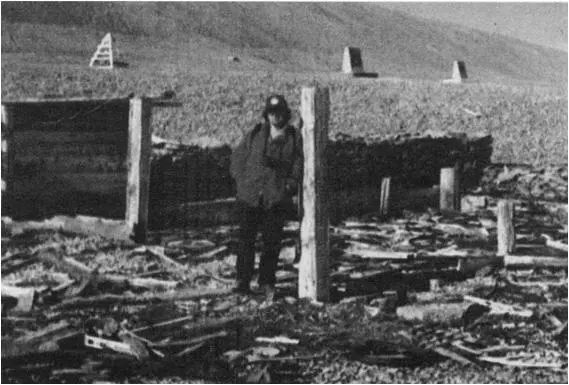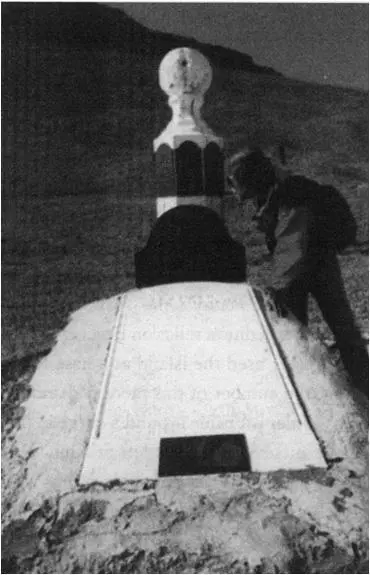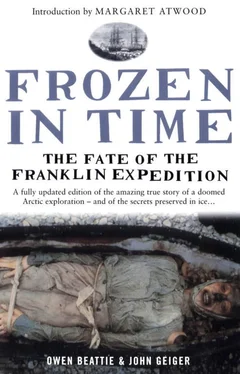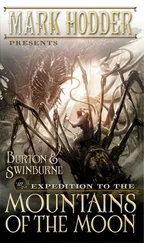As the wait for the final permits continued, Beattie and Damkjar decided to explore the remains of Franklin’s winter camp, then the historic sites along the east coast of the island.
Most of the relics left behind by Franklin’s expedition had already been collected and taken away by the search expeditions that followed. Those that remained were subjected to continual disturbance right up to 1984. Despite this, a number of important artefacts could be seen in the areas adjacent to the graveyard. Most prominent among them was a large gravel-walled outline, believed to have been a storehouse. Also nearby the graves were the remains of a smithy, a carpenter’s shop and, further away, depressions where tent structures or observation platforms once stood. (Between 1976 and 1982, Parks Canada had conducted detailed archaeological investigations of a number of important historical sites in the Arctic. Beechey Island was one of the sites studied. The only artefacts from Franklin’s expedition remaining at that time—besides the structure outlines—were clay pipe fragments, nails, forge waste, a stove door fragment, wood shavings and tin cans.)
Beattie also looked over two graves dating from the searches of the 1850s that had been dug alongside Torrington, Hartnell and Braine. One of the graves was that of Thomas Morgan, a seaman from Robert McClure’s ship, the HMS Investigator. The owner of the other grave is unknown, though one journal from the 1850s indicates that it may be a dummy grave serving as a memorial to French Navy Lieutenant Joseph René Bellot. Both of these men had died heroic and tragic deaths. Morgan had been among the scurvy-wracked from the Investigator who—before the Franklin expedition achievements were discovered—had been credited with being the first to cross the Northwest Passage. Having abandoned the ice-locked Investigator with the rest of McClure’s crew at Mercy Bay on the north coast of Banks Island, Morgan had made the difficult trek by foot over the ice first to Dealy Island, then later reached Beechey Island, only to die aged thirty-six in May 1854 on board the HMS North Star. Bellot, who had served in the French Navy with distinction, later volunteered to join in the Franklin search. Bellot visited the Arctic first under Captain William Kennedy aboard the Prince Albert, then later aboard the HMS Phoenix. On 18 August 1853, while carrying dispatches to searcher Sir Edward Belcher up icy Wellington Channel, Bellot was caught by a gust of wind and swept into the frigid water. His body was never recovered.
Beattie and Damkjar, leaving the graves and adjacent Franklin campsite behind them, walked south along the beach ridge above the waterline. The first artefacts found along their route were tins, scattered individually or in small clusters. Close inspection of the cans identified them as being from the supplies of the search expeditions. Not only had Captain Horatio Thomas Austin and Captain William Penny—the searchers who had first discovered Franklin expedition relics on Beechey Island—spent time here, but others later used the island as a base for their searches. Walking along, the number of tins increased and wood fragments also became evident. Visible around a curve in the coastline was the mast of one of several vessels left at King William Island during the 1850s—jutting at a steep angle out of a gravel beach ridge. The vessel, which was probably left on the island to serve as a depot, was still largely intact in 1927 when Sir Frederick Banting, codiscoverer of insulin, and Canadian painter A.Y. Jackson visited the island on a sketching trip. The mast, and a small section from the hull of the vessel, which lay flat on one of the lower beach ridges, were all that remained for Beattie and Damkjar to inspect.


ABOVE Owen Beattie standing at the ruin of Northumberland House, the supply depot built in 1854 by the crew of the North Star , part of the fleet commanded by Belcher.
BOTTOM Eric Damkjar inspecting the monument erected by Sir Edward Belcher to commemorate all those who died searching to discover the fate of Franklins expedition.
Along one of the highest beach ridges was a series of recent markers and cairns dating from the 1950s to the 1970s. Also at the site: a memorial combining the monument left by Leopold M’Clintock in 1858 and a cenotaph erected by Belcher as a memorial to all those who died during the Franklin search.
Belcher, commanding a British naval fleet of five ships from 1852 to 1854, ordered that one of these ships, the North Star, under the command of William John Samuel Pullen, remain off Beechey Island as a base for the other vessels. Directly in front of the cenotaph, on a much lower ridge, is the skeleton of Northumberland House, the supply depot built by the crew of the North Star in 1854. It had been in a reasonable and useful state of repair even into the early 1900s, but no longer. Only parts of the wood walls were still visible, though a stone wall had held up quite well. Scattered in and around the structure were hundreds, possibly thousands, of artefacts from the structure itself and the food containers (primarily wooden barrel staves and metal barrel hoops) once housed inside. On 6 August 1927, when Banting and Jackson visited Northumberland House, significant damage had already been done to the structure, though Jackson noted in his journal that “there are a lot of water barrels, thirty or forty of them, that could be used today.” Banting, however, also noted that “Bears had chewed holes in the side of some of the barrels, large enough to admit the head and neck so that they could get the last drop of the contents.” Still, the scattered relics on Beechey Island do not attest to the hundreds of men, from various expeditions, who spent time at the site over the course of the searches of the early 1850s. Even on such a small island, their artefacts are lost among the forbidding landscape.
Peering off the south shore of the island during his survey, Beattie thought of the wreck of the Breadalbane, sent from England with fresh supplies for the ships under Belcher. Crushed in the ice, the Breadalbane sank off the island on 21 August 1853. In 1980, Canadian underwater explorer Dr. Joe Maclnnis located the remains of the remarkably preserved ship under 330 feet (100 metres) of water and, in 1983, led a diving team to visit the wreck.
HMS Breadalbane (left) and HMS Phoenix landing provisions at Cape Riley.
Returning to camp from his hike, Beattie saw that the wait for permissions was taking its toll on everyone’s nerves. Feeling that the permissions would not be granted in time to complete the project that summer, Amy finally decided to return to Edmonton, where he had a number of pressing professional obligations. He left Beechey Island on 15 August.
At last, on 17 August, Beattie received a radio transmission from the Polar Shelf offices in Resolute giving permission to proceed with the exhumation, autopsy and reburial of John Torrington. Hearing the letters of permission read over the radio caused a great sense of relief and fuelled a new surge of energy and enthusiasm. The last letter also detailed the procedures to follow should contagious disease be detected in the Franklin crewmen. Everyone in the Arctic could have picked up the transmission and heard the Polar Shelf radio operator read in part: “If, in the course of the excavations, Dr. Beattie discovers any evidence of infectious disease in the artefacts or corpses exhumed, further digging should be discontinued.”
Читать дальше












